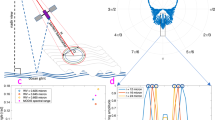Play all audios:

ABSTRACT IN his account of Prof. Størmer's observations on iridescent clouds, Prof. S. Chapman refers to their rapid internal motion.1 It is perhaps worth while to put on record that
this was also a characteristic of the luminous night clouds of the midsummer of 1885, two years after the Krakatoa eruption. I was living in London at the time, at a house in the City, and
obtained from the roof a clear view of the northern horizon at midnight, doubtless the clearer for the miles of built-up area between. The belt of brilliantly white cloud (not iridescent)
lying just above the horizon was in rapid internal movement; after turning away one's eyes for a few seconds the forms of component wisps were found to be quite changed. Considering the
immense distance (probably 400 miles), the movement must have been very rapid indeed. It is obvious that, to be visible from London at midnight, these luminous night clouds were much higher
than the iridescent clouds, and their height might well have been 80 km. Access through your institution Buy or subscribe This is a preview of subscription content, access via your
institution ACCESS OPTIONS Access through your institution Subscribe to this journal Receive 51 print issues and online access $199.00 per year only $3.90 per issue Learn more Buy this
article * Purchase on SpringerLink * Instant access to full article PDF Buy now Prices may be subject to local taxes which are calculated during checkout ADDITIONAL ACCESS OPTIONS: * Log in
* Learn about institutional subscriptions * Read our FAQs * Contact customer support SIMILAR CONTENT BEING VIEWED BY OTHERS FAINT YET WIDESPREAD GLORIES REFLECT MICROPHYSICS OF MARINE CLOUDS
Article Open access 08 November 2022 SMALL LIGHTNING FLASHES FROM SHALLOW ELECTRICAL STORMS ON JUPITER Article 05 August 2020 LABORATORY PREDICTIONS FOR THE NIGHT-SIDE SURFACE ICE GLOW OF
EUROPA Article 09 November 2020 REFERENCES * _NATURE_, 129, 497; April 2, 1932. Download references AUTHOR INFORMATION AUTHORS AND AFFILIATIONS * St. Leonards-on-Sea T. S. DYMOND Authors *
T. S. DYMOND View author publications You can also search for this author inPubMed Google Scholar RIGHTS AND PERMISSIONS Reprints and permissions ABOUT THIS ARTICLE CITE THIS ARTICLE DYMOND,
T. Types of Iridescent Clouds. _Nature_ 129, 798 (1932). https://doi.org/10.1038/129798b0 Download citation * Issue Date: 28 May 1932 * DOI: https://doi.org/10.1038/129798b0 SHARE THIS
ARTICLE Anyone you share the following link with will be able to read this content: Get shareable link Sorry, a shareable link is not currently available for this article. Copy to clipboard
Provided by the Springer Nature SharedIt content-sharing initiative
